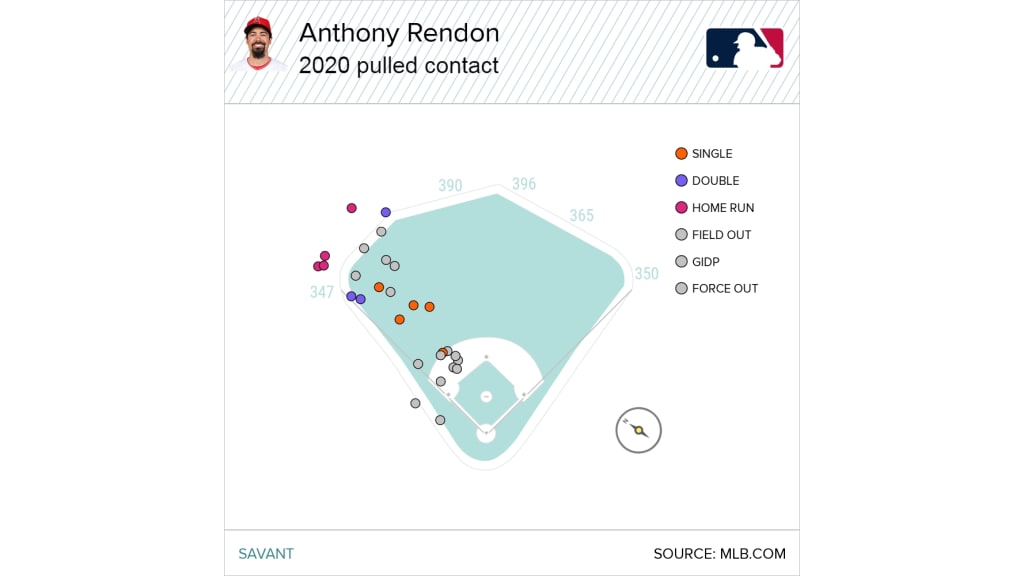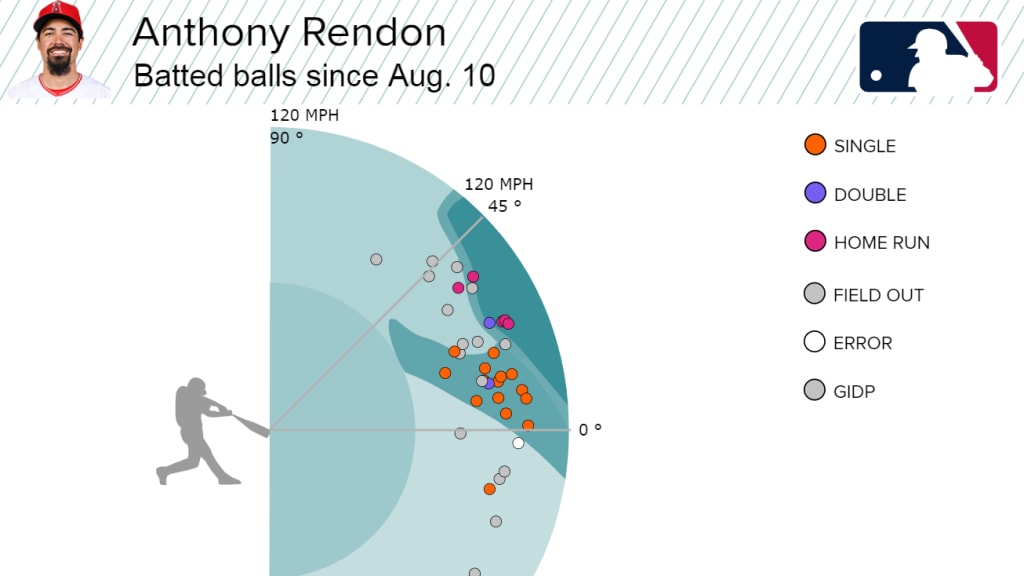Remember when Anthony Rendon was having the worst start of his life? Yeah, we don't either. That might as well never have happened.
But let's compare the stat lines just to see how the pendulum has swung. Here's Rendon on Aug. 9, after his first 12 games, vs. Rendon today, after his last 12 games.
First 12 games: .103 BA / .364 OBP / .205 SLG / .569 OPS / 1 HR / 14 BB / 12 K
Last 12 games: .489 BA / .547 OBP / .872 SLG / 1.420 OPS / 5 HR / 6 BB / 7 K
Season stats: .314 BA / .454 OBP / .570 SLG / 1.023 OPS / 6 HR / 20 BB / 19 K
If the season ended today, the Angels' new superstar would have the highest OPS of his career (he finished at 1.010 last season). Rendon has a 178 OPS+, meaning he's been 78% better than an average hitter; last year he was at 156.
He's the best third baseman in the Majors right now by a wide margin. He's a top-five player in the league. Seriously. Here's the FanGraps WAR leaderboard right now:
Most Wins Above Replacement, 2020
- Mike Yastrzemski (SF): 2.1
- Fernando Tatis Jr. (SD): 2.0
3-T) Anthony Rendon (LAA): 1.7
3-T) Brandon Lowe (TB): 1.7
5) Kyle Lewis (SEA): 1.6
6-T) Mookie Betts (LAD): 1.5
6-T) Bryce Harper (PHI): 1.5
The next-closest third baseman by WAR is Matt Chapman at 1.2. The next-best offensive third baseman by OPS+ is Kyle Seager at 156. Rendon reascended to MVP level in the blink of an eye. How did that happen?
Here's the secret: the hits were hiding all along. All season long, Rendon has been doing everything right when it comes to his hallmark, plate discipline. He was always swinging at all the right pitches; he just needed to hit them. Now the hits are coming. No one should be surprised.
When the Angels signed Rendon, the dream was for him and Mike Trout to be the best duo in baseball. It's coming true. Here's why Rendon was able to turn things around so fast.
He's as disciplined as ever
The key to slump-busting can be hard to pinpoint. As Rendon quipped this week, "If I could tell you that answer then I probably wouldn't go 0-for-12-games or whatever it was."
But the thing is, Rendon didn't have to change his approach to break out. His approach is great. It was great during his first game this season, it's still great now. The foundation was in place the whole time.
The first thing to look at with plate discipline is how often a hitter chases pitches out of the zone. Rendon's chase rate this season is only 14.6%, a personal low (down from 20.7% last season) and one of the lowest of any MLB regular.
Lowest chase rate, 2020
Minimum 200 out-of-zone pitches seen
- Cavan Biggio (TOR): 11.9%
- Max Muncy (LAD): 14.1%
- Matt Olson (OAK): 14.5%
4) Anthony Rendon (LAA): 14.6%
5) Carlos Santana (CLE): 14.8%
6) Mike Trout (LAA): 15.0%

Rendon's chase rate wasn't any higher during his 12-game cold snap. In fact, it was slightly lower than his overall season mark, 12.8%. So swinging at bad pitches was never a problem.
Rendon has a great sense of the strike zone; he knows which pitches to attack. This season, he's swinging at essentially nine of every 10 pitches that are middle-middle in the zone (Statcast calls those "meatballs"). Rendon's 88% meatball swing rate is the highest he's ever had, almost 10 percentage points higher than the 79% clip he attacked those perfect strikes at in 2019. And he's only swung at seven of the 150 pitches he's seen that are more than a baseball's width off the edge of the plate; only Brandon Nimmo, also known for his strong discipline, has laid off those balls more often.
He's adopted the Angels' selective approach
Last year, the Angels notably embraced a hitting philosophy of selectivity. While it falls under the plate discipline umbrella, discipline has more to do with "attacking strikes and laying off balls," where selectivity is more "only swing at the pitches you really want to" -- as in, reducing swings, even sometimes at pitches in the zone.
Angels hitters like Mike Trout and David Fletcher are exemplars of this strategy, posting among the lowest swing rates in the league. Now that Rendon is their teammate, he's moving in that direction, too.
It's not just Rendon's chase rate that's down in 2020. His overall swing rate is down, to 38%, his lowest since the 2015 season and the same as Trout's 2020 swing rate. His first-pitch swing rate is down from 26% in 2019 to 17% in '20, among the lowest in MLB -- and that's an Angels thing, as Fletcher (10%), Albert Pujols (12%), Tommy La Stella (14%) and Trout (15%) offer at the first pitch even less than Rendon.
Selectivity meshes easily with the elite discipline Rendon brought with him to Anaheim. He and the Angels lineup were made for each other.
As Rendon said, "I try to only swing at pitches in the zone every year. It's a small sample thus far, but hopefully I can keep it going and still try to swing at pitches in the zone."
He's succeeding at that all season. That should be a good thing for a hitter.
So … why was he slumping?
What Rendon needed was to turn those swings into better contact. He was swinging at the right pitches, but he wasn't hitting them.
Here are some of Rendon's key stats for 2020 through Aug. 9, compared to his 2019 numbers:
Swing-and-miss rate: 22.4% (2019 season: 12.9%)
Hard-hit rate: 33.3% (2019 season: 46.6%)
Barrel rate: 3.7% (2019 season: 12.0%)
xBA / xSLG / xwOBA: .173 / .307 / .332 (2019 season: .318 / .605 / .423)
A hard-hit ball is 95 mph or harder. A barrel is even better -- it's a ball hit with both ideal exit velocity and ideal launch angle, likely to be a home run or an extra-base hit. Expected batting average, expected slugging percentage and the overall expected wOBA (wOBA is like on-base percentage except it gives credit for things like home runs being better than singles), are based on a hitter's quality of contact. Long story short: Rendon's quality of contact was down across the board.
And even though he was swinging at strikes, he was fouling off a lot of those pitches -- over half of his in-zone swings resulted in foul balls during his first dozen games. He's cut that down significantly since.
The oblique injury that kept Rendon out to start the season might very well have been why he wasn't driving the ball. It's hard to get that all-important torque in your swing when your oblique is hurt. Remember, an oblique injury is what Aaron Judge dealt with last season when his pull power disappeared. Fast forward to this season, and Judge starts crushing homers to left field again. Now Rendon is doing the same thing.
Rendon's turned things around to such a degree that his quality of contact metrics are now all stellar. His 2020 season xBA is up to .298. His xSLG is up to .522. His xwOBA is up to .409 (over .400 is extremely good).
How did he fix it?
There are two reasons Rendon was able to maximize his contact despite the lower hard-hit rate:
- He's pulling the ball more
- He's a line-drive machine
Pulling the ball makes it easier to tap into your power. Rendon is pulling 42% of his batted balls in 2020, compared to about 37% in every other season of Statcast tracking (2015-19). He's still skilled at hitting center-oppo, of course -- just look at his four-hit game Friday, where three of his hits were to center or right-center.
But Rendon's power numbers this season are to the pull field -- he's slugging .964 when he pulls the ball, including seven of his 10 extra-base hits (four of his six home runs, three of his four doubles.)

But the bigger key to Rendon's surge isn't his spray direction ... it's his launch angle. Specifically, Rendon is top-10 in MLB in "sweet spot" contact -- that's how often he hits the ball in the ideal launch angle range of 8-32 degrees. This season, 43% of Rendon's batted balls are in the sweet-spot zone. That's a ton.
Rendon is a very tough hitter to strike out. He's usually either walking or making contact. When you walk a lot, and then a lot of your contact is also in the sweet spot, your numbers are going to be good. On Rendon's sweet-spot contact this season, he's batting .621 and slugging 1.138. And we're talking about nearly half of everything he hits.
What makes the sweet spot the sweet spot is that it encompasses both optimal launch angle zones: 8-16 degrees is the best for base hits, because those launch angles are line drives; 24-32 degrees is the best for home runs, because those launch angles are fly balls.
Of those two zones, Rendon is leaning heavily into the line drive range. In fact, he has a top-five line-drive rate in MLB.
Highest line-drive rate, 2020
Min. 50 batted balls
- Jake Cronenworth (SD): 44.3%
- Luke Voit (NYY): 44.0%
3) Anthony Rendon (LAA): 41.8%
4) Robinson Canó (NYM): 41.2%
5) Austin Nola (SEA): 39.7%
Ranking among the league leaders in line-drive rate would be good no matter what, but it's especially good for someone like Rendon, who's working to regain his old hard-hit and barrel numbers. If you're hitting fly balls, you absolutely must hit the ball hard; it's the difference between a home run and a flyout. But line drives get good results for the hitter even at lower exit velocities. They are the best type of contact for simply getting hits.

Overall, MLB hitters have a .637 batting average on line drives this season. And even on non-hard-hit line drives -- those with an exit velocity under 95 mph -- the league batting average is still .548. By comparison, on fly balls hit under 95 mph, the league batting average is just .110.
Hard-hit fly balls are good for home run power. Non-hard-hit fly balls are good for nothing. Line drives are always good. Rendon is hitting more line drives than almost everyone else, and he's batting .679 on those line drives.
And that's just for the season overall. Since his hot streak began, Rendon's contact numbers are unreal. Over half of his batted balls since Aug. 10 are in the launch angle sweet spot (53%) and over half are line drives (55%).

All of this is very good. Which makes sense, because Rendon is very good. Now his numbers finally look like it.
